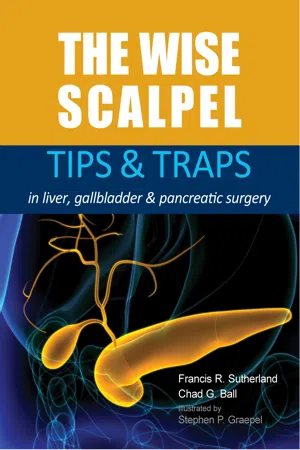
The Wise Scalpel
Tips & Traps in liver, gallbladder & pancreatic surgery
- English
- ePUB (mobile friendly)
- Available on iOS & Android
The Wise Scalpel
Tips & Traps in liver, gallbladder & pancreatic surgery
About this book
Surgery remains a challenge for young learners. Perhaps the most difficult of all surgeries are those done on the liver, biliary tree and pancreas. These organs are difficult to expose, difficult to operate and the patients are often difficult to recover. There are significant consequences for any missteps on what is a narrow pathway to a successful outcome.The skills needed to master surgery on these organs are hard to acquire. The volume of information presented to students is enormous and complex to parse. HPB textbooks contain a large amount of information from various authors but are often poorly coordinated. Surgical manuals contain significant anatomic details and descriptions but have difficulty transferring key concepts. Experienced surgeons are often oblivious to their skills and communicate poorly to their students regarding the things they do or understand that make them wise. This book tries to capture this wisdom.The topics in this book are most applicable to hepatobiliary and pancreatic surgeons but really extend to all general surgeons. Anyone who operates in the abdomen must have a basic understanding of these dominant organs, general surgery trainees and staff are an additional focus of this book. The skills needed for a modern surgeon to succeed are much broader than the scalpel tip. Section I, "HPB Surgical Craft", imparts important lessons on the laws of human interactions and cognitive aspects of surgery. Sections on the anatomy and operations on the liver, pancreas and bile ducts are presented. The expanded gallbladder section and pancreatitis chapters are of particular importance to general surgery residents. This book has been written in a readable and entertaining style, with many fun historical and contemporary quotes dotted throughout.The Wise Scalpel is an attempt to impart knowledge and understanding to students and practicing surgeons at all levels. The book focuses on tips, traps and underlying truths about the diseases of these organs and their surgical treatment. While this book will not supplant the struggle needed to move from novice to expert surgeon, hopefully it will quicken the process and help avoid some of the dangers and frustrations along the way.
Frequently asked questions
- Essential is ideal for learners and professionals who enjoy exploring a wide range of subjects. Access the Essential Library with 800,000+ trusted titles and best-sellers across business, personal growth, and the humanities. Includes unlimited reading time and Standard Read Aloud voice.
- Complete: Perfect for advanced learners and researchers needing full, unrestricted access. Unlock 1.4M+ books across hundreds of subjects, including academic and specialized titles. The Complete Plan also includes advanced features like Premium Read Aloud and Research Assistant.
Please note we cannot support devices running on iOS 13 and Android 7 or earlier. Learn more about using the app.
Information


get your thinking clean to make it simple. But it's worth it in the
end because once you get there, you can move mountains.







Table of contents
- Cover
- Title Page
- Copyright Page
- Table of Contents
- Contributors
- Dedication
- Introduction
- SECTION I — HPB surgical craft
- SECTION II — Liver
- SECTION III — Porta hepatis
- SECTION IV — Gallbladder
- SECTION V — Pancreas
- SECTION VI — HPB extras
- Epilogue Parting thoughts
- Index
- Back Cover